Rodent Prevention
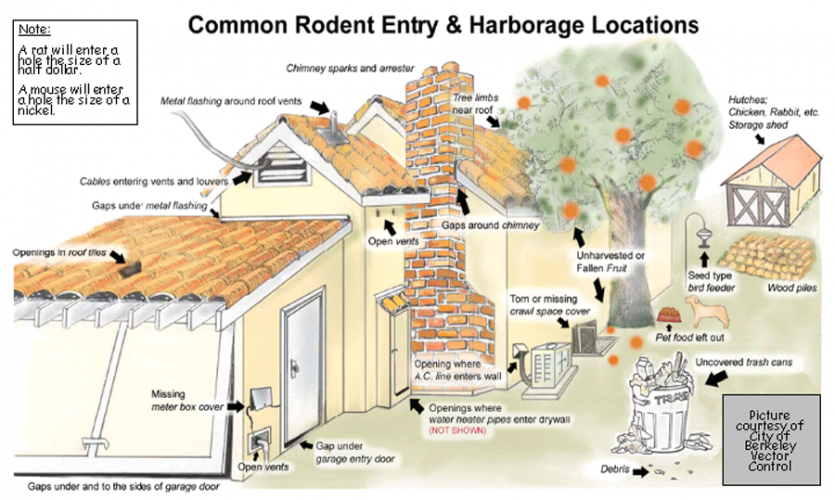
Rodents are very clever about entering your home, but there are some common entry points that you can keep an eye out for. Be aware that any gap greater than ¼ inch could potentially admit a rodent, so look closely when you do an inspection!
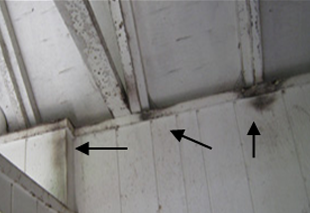
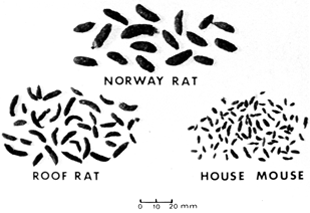
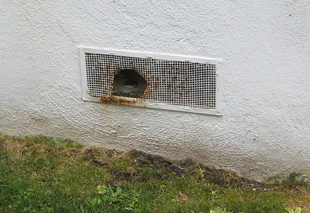

- Live rat sightings. Rats are most active after dark and you can often hear or see them running around.
- Rub or grease marks. Rats will often use the same route of travel to move between their nest and sources of food or water. This is called a ‘runway’. Over time, dirt and oils from their fur will leave a smudge or stain on walls or other surfaces. You may see these rub marks on beams or rafters, on vertical pipes, or along ledges. You may also see swing marks where rats ‘swing’ their bodies under obstacles.
- Rodent droppings. Look for rodent droppings around compost or garbage bins, near pet food bowls, or in attics. New droppings look shiny, old droppings look dusty. If you aren’t sure, clean the area (wear gloves and spray areas down with disinfectant ) and watch for new droppings.
- Gnawing damage. Rats gnaw to enlarge holes, gain access to structures or containers, to “taste” novel surfaces, or just for fun. Gnaw damage can be seen on plastic or cardboard containers, wiring, or access points to the outside. Wire damage may cause house fires. Rats have two lower incisors and most containers will show two knife-like teeth marks per bite.
- Tracks in dust. Rats have very small tracks with four toes on the front feet and five toes on the back. The tail usually does not drag. Rats usually like to sit and eat or gnaw and do not run back and forth much so the tracks are distinct. Mouse tracks are much smaller. Mice run back and forth a lot causing the tracks to be muddled and look like a lot of overlapping dots.
- Burrows or holes. Norway rats create burrows or holes for nesting and storage. All rats may create holes to gain access to structures.
- Stored food caches. Rats sometimes drag food to a safe location to consume it, or cache for later. You may see piles of snail shells, wrappers, or vegetation in sheltered locations. Rats will also leave bite marks on fruits, vegetables, food containers, or nuts. Roof rats often gnaw the peel from citrus fruits on trees, leaving the flesh behind.
- Noises. If rats get inside your house or other structure, you may hear noises – feet pattering, small thumps, squeaks, or gnawing noises - from the attic or walls, especially at night. Outdoors in the evening and morning you may hear vegetation rustling.
- Bad smells. Severe infestations may create odors from urine or droppings. If rodents die in the walls there may be a ‘dead animal’ smell as well as a large number of flies appearing indoors.
- Parasites. Infestations may also bring with them rat fleas or mites that may bite people.
Rats are looking for food, water and shelter and when they have access to any of these on your property, they are more likely to try to move in and stay.
Eliminate Rodent Harborage
- Rats dislike being out in the open and will seek cover whenever possible. You can make your property less hospitable to rats by cutting back vines, creating space underneath and between shrubs, and creating open space or walkways between planting beds.
- Some plants especially attractive to roof rats include: Algerian and English ivy, blackberry, jasmine, honeysuckle, bamboo, pampas grass, bougainvillea, oleander, and Italian cypress. Keep these plants thinned to discourage rats from nesting.
- Fruiting plants and trees provide a food source for rats, including citrus trees and vegetable gardens. Make sure you remove fallen fruits and stay on top of harvesting ripe produce. Avoid planting ornamental trees that produce inedible fruit. Sheet metal collars can be used to keep rats from climbing tree trunks, but are only effective if the rats cannot jump to it (rats can jump 4 feet!).
- Firewood and stacked lumber should be stored a minimum of 18 inches above ground and 12 inches away from fences and walls.
- Garbage, toys, storage overflow, or debris should be discarded or stored indoors to avoid creating harborage for rats.
- Stored vehicles can sometimes be infested by rats; this can be avoided by regularly uncovering, starting, and moving them.
- Trees and bushes should be trimmed back at least 4 feet from roof and walls so that rats don’t jump from the tree to the roof line.
Limit Access to Food Sources
Rats will eat almost anything and their sharp teeth allow them to easily tear through bags and plastic containers. Denying rats access to food sources not only discourages them from coming around, it helps drive them to the bait in traps and bait stations, making other control measures more effective.
- Do not overfeed your pets. Only supply as much food as can be eaten at that time, and clean up any spilled or leftover feed.
- Clean up birdfeeders. Feeders should be of a rat-proof design or should be brought inside at night. Any spilled seed on the ground should be cleaned up. If you are experiencing an active rodent infestation on or near your property, stop feeing all wild animals.
- Store animal feed, compost, and garbage in metal containers with tight-fitting lids. Rats can easily chew through plastic and their urine and droppings will spoil the entire bag of feed, causing illness or spreading diseases.
- Do not feed feral cats. There is no evidence that feral cats directly suppress rat populations. Rats, especially large ones, are ferocious fighters and feral cats simply have no interest in tangling with them, especially if you’ve provided them with something tastier. Feral cats also are infested with parasites, hunt and kill native birds, and commonly carry diseases such as toxoplasmosis, so you might be creating a bigger problem for yourself by encouraging them to stick around.
- Eliminate leaks and standing water. Not only does this provide habitat for mosquitoes, it provides an important resource for rats as well.
Repairing and closing entry points (called “rodent proofing”) is absolutely crucial to controlling rodent infestations. Rats will try to return to their nest once they have been excluded and will even attempt to make new access points. Continued vigilance is critical to ending the infestation and preventing a new one from starting.
Rodent proofing for apartments and homes
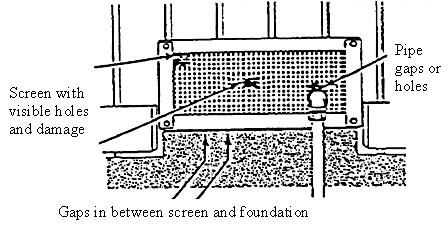

- Holes in vents. Vent covers can rust over time and become brittle. Fortunately, they are easy and inexpensive to replace. Use metal mesh hardware cloth that has opening of ¼ in or smaller. Make sure all attic vents and crawlspace vents are covered with ¼ in or smaller screen.
- Gaps around doors and windows. Always make sure you have intact weather stripping. Not only will it keep rodents out, it’ll keep out bugs and lower your heating bill too! Poorly-fitting windows and doors should be replaced or repaired. If a window stays open, it should be well-screened. Remember: if you can fit your thumb in the crack, a rodent can get in!
- Cracks in foundations and walls. Be sure to check all the way from the ground to the roof. Rats can climb up textured walls and enter cracks at the roof line. You can fill cracks with epoxy sealants or if it is a large crack, cover with sheet metal or wire mesh.
- Openings to the roof. Gaps can appear at the roofline around vents, skylights and chimneys. Chimneys should always have a cap to exclude rats and wildlife.
- Openings where pipes, wires, and cables enter the home. In older holes these were often drilled large and are major access points for rats. Cover these openings with metal ¼ inch hardware cloth, sheet metal, or cement filler.
- Drain pipes. Rats can climb up drain pipes to get to the roof or attic area. Place rat guards or metal cones on drain pipes to prevent rats from climbing them
- Openings in roof or eaves. At the junction of roof pitches or gables, there may be openings that allow rats to access the attic. Cover these gaps with metal ¼ inch hardware cloth or sheet metal. Replace missing or broken roof tiles.
- Underground. Norway rats are very good at burrowing and can enter the home underground or through the sewer lines. They find breaks in pipes caused by faulty joints, poor construction, or by tree roots. You can sometimes find their burrows in yards, under sidewalks, driveways, or under buildings.

Rodent Proofing for Mobile Homes
- Close all holes in skirting larger than 1/4 inch - use metal hardware cloth or steel wool to cover or fill holes and gaps.
- Older mobile homes with vinyl or metal skirting can be repaired by first making sure the bottom track at ground level is in good shape. Having the track set on cement is preferred because it can be secured with concrete anchors. A hard surface under the track will also help stop animals attempting to dig under the skirting. With a good track in place, new skirting can be installed.
- Newer mobile homes use wood or Hardie Board for the skirting around the base of the home. They tend to be sturdier than the metal panels of older homes. Animals may dig under the skirting but you can use wire mesh or pavers to fill the gap of the compromised area.
- Use tape or other materials to seal openings in under-belly wrap, including openings where pipes enter the home.
Work with your neighbors
Chances are if you are having rodent problems, your neighbors are having problems too! An integrated approach, with everyone working together is the best approach. As a group, you can make a commitment to follow the guidelines above to make your neighborhood a place where rats are discouraged from establishing.
District staff cannot write citations or force your neighbor to remove rodent attractants from their property. Unless there is a public health risk, residents cannot be forced to conduct rodent-proofing on their own property. If you believe the situation represents a threat to human health or safety, you may contact your city’s code enforcement department.
If you would like to schedule a presentation or request additional brochures for your group, please contact the district at 650-344-8592.
Page last reviewed: July 10, 2025
